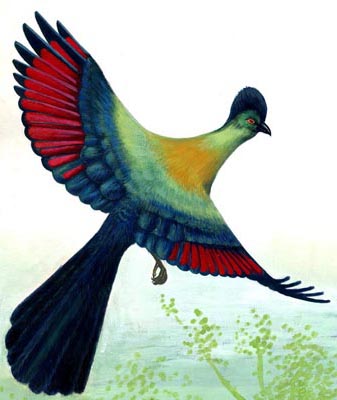The ENTC now has a new website, at www.entc.org.sz
Our logo is adapted from a painting by Phillip Dlamini, 1998, of a purple crested turaco. In traditional Swazi dress, the red feathers feature in the royal headdress, so this bird illustration is not only a symbol for wildlife conservation, but also of cultural heritage.



The reserve lies within the transitional zone between two biogeographic regions, the dry thorn savannas of the west, and the moister coastal thickets of the east. The reserve consists of three distinct ecological zones, the Ndzindza plateau, the Siphiso Valley and the rhyolite ridges of the western boundary. Although small, the reserve is contiguous with other protected areas (Mbuluzi and Simunye Nature Reserves, Hlane Wildlife Sanctuary), and other areas of natural vegetation (north bank of the Mbuluzi River, Mhlumeni area, adjacent area in Mozambique).
The Lubombo mountains are the most impressive natural feature of the reserve; they are a rhyolite ridge running from south to north along the border with Mozambique, volcanic in origin and geologically young. The perennial Mbuluzi river runs along the northern boundary of the reserve, passing through an impressive river valley in the north-east. The much smaller Mlawula stream flows through the west of the reserve. West of and parallel to the Lubombos is the basaltic Siphiso valley, a low-lying savanna area with abundant game, flanked on the west by a chain of low rhyolite ridges.
The Lubombo plateau it self is an open bushclump- studded area that dips gently to the east. It is dissected by a number of steep-sided forested ravines that drain northwards into the Mbuluzi river. A few small closed depressions, or seasonal pans, occur on the higher parts of the plateau, and when filled with rainwater are an extremely interesting and locally unique feature.
The Mlawula area was considered as worthy of protection for many years, and was in fact proclaimed as a protected area as far back as 1914; it was subsequently deproclaimed and subdivided into cattle ranches.
The first part of Mlawula to be reproclaimed as a conservation area was the then Blue Jay Ranch, which was donated to the Swaziland National Trust Commission by the Niven family and gazetted in 1978 as Ndzindza Nature Reserve. This move was shortly followed by the purchase of Mlawula Estates, which development was in part funded by Havelock Mines (Pty) Ltd., and the donation of Nyala Ranch by Tibiyo.
Our Contacts:
Head Quarters: (+268) 2416 1489/1179
Email: info@sntc.org.sz
King Sobhuza II Park: (+268) 2416 1489/1179
Email: ksmp@sntc.org.sz
National Museum: (+268) 2416 1489/1179
Email: curator@sntc.org.sz
Copyright © ESWATINI NATIONAL TRUST COMMISSION
Malolotja Nature Reserve: (+268) 2444 3241 / (+268) 2416 1480
Email: culturalvillage@sntc.org.sz
Mantenga Nature Reserve and Swati Cultural Village: 2416 1151/1178
Email: culturalvillage@sntc.org.sz
Mlawula Nature Reserve: (+268) 2383 8885 (Reception)
(+268) 2383 8453 (Senior Warden)
Email: culturalvillage@sntc.org.sz
Magadzavane Lodge: (+268) 2343 5108/9
Email: magadzavane@sntc.org.sz